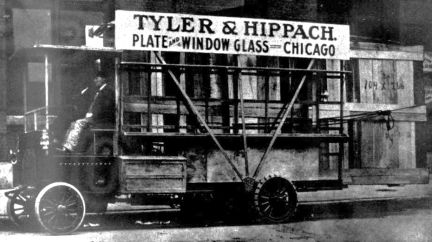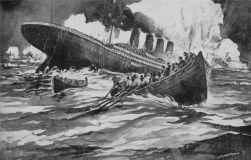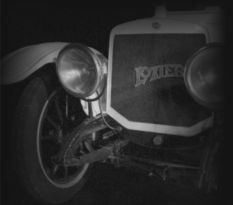|
Iroquois Theater fire
Fourteen-year-old Robert L.
Hippach (b.1889), a student at the Gowdy School, and
his brother, eleven-year-old Archibald A. Hippach
(b.1892), were the children of Louis A. Hippach
(1868-1935) and Ida S. Fischer Hippach (1866-1940).
The family lived at 2928 Kenmore Ave. in Chicago.
Nothing was reported about the theater party of
which Robert and Archibald were members. It could
have been made up of family members or schoolmates;
it is safe to assume they were not alone. Newspaper
reporters were ravenous for information about
victims, especially those from affluent families,
but got nothing from the Hippachs other than funeral
times and places. If the dead boys' mother took them
to the theater and survived, however, the omission
of details is in keeping with the way that was
handled by other Iroquois victims' families.
Robert's body was found at Sheldon's funeral home
and Archibalds at Gavins. The double funeral was
held at the Church of the Atonement at Kenmore and
Ardmore avenues in Edgewater, Illinois. Many of the
boys' classmates were in attendance. They were
buried in the Hippach family plot in Rosehill
Cemetery in Chicago.
Hippach prosperity
Louis Happach was co-owner of Tyler & Hippach, a
successful manufacturer of plate glass. Hippach's
company supplied architectural glass for the Field
Museum and Merchandise Mart in Chicago.
 He was from
Wisconsin and Ida from Illinois. There were two
younger children left at home after the family's
Iroquois Theater loss: Jean Gertrude Hippach
(b.1894) and Howard H. Hippach (b.1896).
He was from
Wisconsin and Ida from Illinois. There were two
younger children left at home after the family's
Iroquois Theater loss: Jean Gertrude Hippach
(b.1894) and Howard H. Hippach (b.1896).
The Titanic, in 1912
Ida and nineteen-year-old Jean traveled to Berlin and France to further Jean's
music studies and help Ida overcome grief at the loss of her boys.
They booked passage on the Titanic for
the trip home, occupying cabin B-18 as
first-class passengers.
John Jacob Astor IV had helped his beautiful young wife board lifeboat #4, assuring her
that he would follow in another lifeboat. The crew
had started lowering the lifeboat when Aster saw Ida
and Gertrude. He commanded the crew 
to stop lowering the boat while he rushed Ida and Jean to a lower
deck and helped them climb through a porthole into
the half-lowered lifeboat. As a disaster
specialist,
Marshall Everett, author of the first book about
the Iroquois Theater fire, wrote about the sinking
of the Titanic. In the Wreck of the Titanic he
included
a lengthy section of Jean Hippach's description of the ship and her escape.
|

|
The forty-seven-year-old Astor's wife,
his second, Madeleine Talmage Force, was
nineteen years old and pregnant.
As the richest man in the world at the
time, his marriage to Madeleine so scandalized
society that they were shunned. As so wonderfully
depicted by Kathy Bates in the 1997 movie, Titanic,
"Unsinkable Molly" Margaret Brown was happy to thumb
her nose at society and traveled with the Astors to
Egypt and France.
Howard Hippach's death
In 1914, the third son, Howard H. Hippach (1896-1914),
died in an automobile crash. Ida, Jean and
Howard were living at Lake Geneva, Wisconsin while their new home in
Evanston was under construction. On
October 13, 1914 driving a Lozier touring car when
it skidded in mud, and slid, causing a tire to fall
off, and flipped several times down into a ditch.
Newspapers reported that he was crushed to death
under the  right front fender and died instantly.
Newspapers reported three different stories about
the cause of the accident. In one story an eye
witness said the skid was caused when Howard glanced
at a newspaper. No mention of a dog. In
another story, he looked away
from the road to cover his dog with a blanket.
Neighbors heard the crash and ran to the scene where
they found his dog guarding his body. In the
third story, he took his hands from the steering
wheel to place a blanket on his feet.
Neighbors heard a dog barking and ran to the scene.
right front fender and died instantly.
Newspapers reported three different stories about
the cause of the accident. In one story an eye
witness said the skid was caused when Howard glanced
at a newspaper. No mention of a dog. In
another story, he looked away
from the road to cover his dog with a blanket.
Neighbors heard the crash and ran to the scene where
they found his dog guarding his body. In the
third story, he took his hands from the steering
wheel to place a blanket on his feet.
Neighbors heard a dog barking and ran to the scene.
In Howard's memory, the Hippach family donated a new
athletic field to the Abbott School in Farmington,
Maine, his alma mater, where he had played on the school baseball, football,
and basketball teams. The Howard H. Hippach field
was dedicated in June, 1916. The family of one of Howard's
friends, John Giles Mohler of Columbus, Ohio,
donated a new field house in Howard's name,
including a portrait of Hippach.
Two years earlier Howard had traveled with
his father to New York on the Twentieth Century
Limited to meet his mother and sister arriving on
the Carpathia with other Titanic survivors.
Child killed, Jean robbed and sued
In the summer of 1915, Jean Hippach was riding in a
car driven by her chauffeur, Hugo Carlson, on
Lakeshore Drive in front of the Lincoln Park
Sanitarium when the Diedling family of six crossed
the road, and eight-year-old John Diedling jr was
hit. Carlson and the boy's father hurriedly got him
in the car and took him to the nearest hospital,
where he died on arrival. Jean's suitcase containing
her riding boots was in the car at the time of the
accident. While she and Carlson were out of the car,
a thief stole the suitcase. The Diedling's sued the
Hippach's for $1,000. ($25k today).
Escaped bombing
In 1922 police foiled a series of bombing targets
among Chicago companies, including the Tyler &
Hippach Plate Glass Company. The plotters were labor
leaders turned mobsters.
Ida Hippach left an estate of $85,000 to Jean in
1940 (comparable today to $1.5 million), who by that
time had married Hjalmar Unander-Scharin of Sweden.
They later divorced and Jean lived in Osterville,
Massachusetts at the time of her death in 1996. She
had three children.
|
